|
|||||||||||||||
Friday February 10, 2006 8:00 am Ballina NSW
The following material was copied from a blog that I created between June and August of 2005.
Monday, June 06, 2005
First Message
This is primarily a test to verify that I know how to post messages successfully. There is little point in continuing these activities until I am confident they are appearing here rather than on the far side of Pluto, which is where my trashed files end up.
posted by Dale @ 1:47 PM
Tuesday, June 07, 2005
novice difficulties
I am aiming for fairly regular posts. But as I tried to make my second post I realized that I had not made a note of my username and password for this activity. Fortunately the system is Dale-proof and my email address was sufficient to obtain this information. So I am back in business.
The title of this blog (my first) has three key words. Each captures an important role. Of the three, Learning holds center stage. On the right is Self-directed, and on the left is the Web. The spotlight is on Learning. An interest is this topic drives my other professional interests. The emphasis on self-directed helps set the scene as I am primarily interested in Learning that is initiated by the learner. There are at least two senses in which this is important. One, all Learning might be said to have this dimension as an individual who is genuinely not interested in Learning is unlikely to experience much in the way of Learning. Two, my interest is more in Learning that is genuinely initiated by the individual than in an educational process that has been formalized. Much (most?) learning occurs outside of schools and universities. It occurs when one is alone, it occurs when one is on the job, it occurs when one is socializing and it occurs when one is playing. Finally, there is the Web. Although technology has a subservient role, it is still a major player. The Web may be a youngster on the stage but the role is becoming increasing important as the play develops.
The above metaphor may be a bit strained, but it is a beginning. Comments are welcome.
posted by Dale @ 3:55 PM
Wednesday, June 08, 2005
posting images
This morning I Learned how to post images to this blog. The initial goal was to have a small thumbnail of myself appear in my profile. The first effort placed it on the blog as a new post. I then Learned how to delete this post. I then realized that the profile image required a link to the image on a web server. Each day brings something new.
At the moment I am Learning more about how to use the Blogger software than using the software to Learn about something else (i.e. sharing some thoughts about Learning using the Web). This makes perfect sense to me. Each time one discovers a new tool, there is a step backwards as one becomes familiar with it before one can apply it to a useful purpose. Mechanics have over a hundred different tools, which they use with their hands. How many tools should one have that can be used by one's mind? For example, my favorite tools are Dreamweaver, Inspiration, MindGenius, cmap, Excel, Mathematica, AceFTP, Picasa and ZoomBrowser.
I forgot to mention pen and paper!
A couple of days ago I added Blogger and this morning I added Hello (which allows me to easily place images on this blog). Some people find the Learning associated with technology to be overwhelming, but I find it exciting. Life is not meant to be boring.
posted by Dale @ 8:22 AM
Friday, June 10, 2005
Books
Excitement this morning. A couple of days ago I faxed an order for a calculus textbook, but then last night I noticed that the Web page that I used for the invoice had last been updated in 2002. I sent them an email asking if the order would still be filled and I have just received word that my order has been shipped.
I am still amazed at the high level of communication that is possible via the Web. I obtained the order form by printing a Web page and could have placed the order via the Web as well, but there was a message indicating that the process was not electronically secure so I opted for fax for that step. Later this morning I will check my charge card status via the Web to see if I have been debited the correct amount.
I am also using VOIP (Voice Over Internet Protocol) to talk to colleagues in Australia for free (legally!). And I am using this Blog to share these thoughts with others.
I received an Honors B. Sc. degree from the University of Alberta in 1965 in Mathematics but have not used that knowledge in any specific way since then. Needless to say my calculus knowledge is a bit fuzzy. I have begun reviving my interest in the topic, which I once found fascinating (!), and have a purchased a variety of books on the subject in the last 6 months. I have used the Web extensively to find reviews and comments on calculus books, primarily using Google and amazon.com. I have then placed orders to both amazon.ca and chapters.ca. At the same time I have browsed a number of bookstores and bought a few books that looked interesting.
As indicated in the title for this blog, note that this is all initiated by myself, with the motivation being simply interest in the topic. Learning can be fun. Particularly when one is in the driver's seat.
posted by Dale @ 6:46 AM
Saturday, June 11, 2005
Reading
I like books.
At the moment I am reading "Seven Pillars of Wisdom" by T. E. Lawrence (aka Lawrence of Arabia - a great movie starring Peter O'Toole). I have been aware of this book for almost as long as I can remember but I was never in a position to match my interest with the actual opportunity to purchase it until a couple of weeks ago while browsing a bookstore in Sydney NSW as we were waiting to return home from a four-month stay in Australia. While noticing a recent biography of Mao Tse-tung in the section on new books (which I had seen mentioned in a Canberra paper a few days earlier in an article on the author, Jung Chang - who also wrote Wild Swans, and which I had bought the previous day) I happened to see the Lawrence book right beside it (someone had placed it there after having second thoughts about buying it). I seized the moment and am glad I did.
If you can follow the convoluted prose in the previous paragraph you may realize that I now have three books to read:
- Wild Swans
- Mao: The Unknown Story
- Seven Pillars of Wisdom
However this morning, after reading a few chapters from Seven Pillars of Wisdom, I was glancing at a book by Michael Spivak called Calculus, published in 1967. I have ordered the most recent edition of this book and am expecting it to arrive next week. In the meantime I had borrowed the first edition from the University library. At one point in a discussion of the properties of numbers Spivak mentions a reference. I turn to the references section and notice the following quotation at the preface to the suggested references:
will do him little good.
Samuel Johnson
posted by Dale @ 8:36 AM
Monday, June 13, 2005
Time Management
I spent a full hour earlier this morning (while waiting for my car to have regular maintenance) making a few notes about studying, with particular reference to mathematics as I am interested in bringing my understanding of calculus up to a fairly high standard.
The question of motivation does not arise in my case as I am definitely interested in this venture. I find mathematics intrinsically interesting and fun.
The primary issue for me is one of time management. I have set up a criterion of 10 hours/week for activities related to the Learning of calculus. Much less than this is equivalent to 0 hours/week. However I am not yet prepared to identify a specific time period during the week as I find that level of precision to be counter-productive. It is enough to monitor my time and simply make sure that there is no slippage of commitment.
Within the ten hours/week I hope to distribute my time across three types of activities:
1) making notes (sometimes on paper and sometimes electronically)
2) completing exercises
3) reflection comments.
However I have two other commitments for time that are directly related to Learning. One is about History where I have identified 3 books that I wish to read:
1) Seven Pillars of Wisdom by T. E. Lawrence
2) Wild Swans by Jung Chang
3) Mao: The Unknown Story by Jung Chang & Jon Halliday.
The other is on the topic of personal journals where I wish to read:
1) John Fowles: The Journals volume 1
2) Coleridge's Notebooks: A Selection
3) Some of the Dharma by Jack Kerouac
4) The Notebooks of Leonardo da Vinci (2 vols.)
A cursory glance indicates 8 additional non-fiction books beyond what I am reading for mathematics.
Finally, I like to have one novel on the go at any one time. Since my classification system is quite elastic, I include "Seven Pillars of Wisdom" as well as "Wild Swans" as falling under this category. This has the advantage of not adding to my total.
Let's tie up the arithmetic and verify that I have a do-able agenda.
1) Mathematics (10 hours/week)
2) History (6 hours/week)
3) Notebooks (5 hours/week)
Total time reserved for Learning: 21 hours/week (average 3 hours/day). This is a substantive commitment, perhaps unrealistic, but worth a try.
I will put mathematics on hold until the Spivak book arrives. History and Notebooks are the foci of the moment.
posted by Dale @ 3:20 PM
Tuesday, June 14, 2005
Straight Lines versus Random Walks
Self-directed Learning always involves a tension between focusing in on a topic and selecting a different topic. There has been a general sense during the last century to favor a specialist approach, exemplified by the saying "Jack of all trades and master of none." My preference has been more eclectic, as one can see from the books I wish to read at the moment (see previous post).
I finished reading "Seven Pillars of Wisdom" last night and this morning I went to the amazon.com web site to see what else I could find on T. E. Lawrence. This quickly moved to a more general search for books on a history of the middle east. Should I buy a biography of T. E. Lawrence, or one on the Ottoman empire, or one on Islam, or one on the overall history of the middle east? Or none of the above? The goal yesterday was to complete Lawrence's book and then move on to a couple of books on China. I know of no formula for making such decisions.
The hour just spent viewing descriptions, excerpts and reviews of a variety of books is itself a valuable activity, one that has only become possible in the last decade with the creation and evolution of the web (thank you Tim Berners-Lee and Robert Cailliau).
While there is a strong feeling of leaving unfinished business, I have decided to move to the two books on China by Jung Chang. Yesterday I commented that books like "Seven Pillars of Wisdom" and "Wild Swans", while clearly non-fiction, could easily be considered novels. However in organizing some the piles of books in my office this morning I noticed a book I purchased in the Calgary airport while waiting for our connecting flight to Lethbridge. This was after about 26 hours in planes and airports so it is no wonder that I forgot that I had bought it. The book, "The Master" by Colm Toibin was a 2004 Man Booker Prize finalist. It is a novel about the life of the writer Henry James.
To summarize: I now have two history books on my list of readings (the two books by Chang) and have a novel that I want to begin, which falls under the category of Literature. I hope to begin both "Wild Swans" and "The Master" today.
Returning for a (brief) moment to the phrase "Jack of all trades and master of none", I tried googling this phrase and found a number of fascinating web sites. Here is the first one, on instructional design: http://www.gdrc.org/info-design/jackofalltrades.html
posted by Dale @ 6:55 AM
Thursday, June 16, 2005
Time Management continued
Since I have a fairly flexible approach to scheduling my Learning activities, I have created the following table to permit monitoring of my progress:

(1) keep track of how much time I spend on a particular activity during the day, and
(2) remember to update the table.
This whole process raises at least two points:
(1) the table provides an overall form of feedback information enabling me to make adjustments to my time commitments throughout the week, and
(2) is this more time consuming and trouble than it is worth?
The latter question must be answered by the individual. I like the feedback at the moment, but may find it tedious after awhile. It does give me a way of not straying too far from my original intention at the start of the week, but it might be possible to accomplish the same aim with some simple mental discipline.
As an aside, you can see that I am beginning to renew my mathematics activities. I now have the Michael Spivak book, "Calculus. third edition", have completed studying the first chapter, and am thoroughly enjoying it. I will add some additional information in a future post on how I create my e-notes for this activity.
posted by Dale @ 11:50 AM
Friday, June 17, 2005
OED
Learning has many facets, more than a diamond.
Yesterday the university library set up a trial period for the online version of the Oxford English Dictionary. I had been discussing the software package Grokker with a colleague earlier in the day and decided to see what the OED had for the word grok. Perfect. The first use of the word was in the science fiction novel Stranger in a Strange Land, which I read forty years ago, and which I still remember. I have just realized that my primary Learning goal is to grok calculus.
I then tried looking up google in the OED. I was surprised that it was not there. There was reference to an arcane cricket term, but nothing on the search engine or using it.
Now to close the circle by looking up calculus. This is getting scary. The first use of the word calculus, meaning computation or calculation, in English was in 1684 by a person by the name of Burnet. The modern meaning as a branch of mathematics was first noted in 1702 when Ralphson published a mathematical dictionary and compared Newton's fluxion's with Leibnitz's differential calculus.
One, me in particular, should look up at least one word in the OED every day. I am optimistic that the library will decide to obtain a regular subscription that would give all students and faculty online access.
posted by Dale @ 1:40 PM
Tuesday, June 28, 2005
Science Books
The last 10 days have been very busy, with trips to Edmonton, Calgary and Toronto. The time in planes and airports gave me an opportunity to complete the 'History' book, "Wild Swans" as well as a thick book of poetry, "The Complete Poems of Anna Akhmatova".I ventured into one bookstore and had a wonderful time purchasing the following books:
Snowball Earth (2003) by Gabrielle Walker. This is the story of a new interpretation of geologic history to show that 700 million years ago the earth was completely frozen over, becoming a giant snowball. Fascinating! I can hardly wait to read it.
The Book Nobody Read (2004) by Owen Gingerich. The title is a delight and the book traces the history of Copernicus'book "De revolutionibus" which first outlined the idea that the sun, not the earth was the center of the universe.
The Labyrinth of Time: Introducing the Universe (2005) by Michael Lockwood. Time is a topic that has always fascinated me. I tend to buy most books that discuss this elusive concept.
On the Shoulders of Giants (2002) by Stephen Hawking. I noticed this book when it was first published and then noticed that it has been republished as a series of five smaller books, each one focusing on one of the major sections of the original book. The book is a compendium of the writings of five famous scientists: Copernicus (note the overlap with the second book in my list), Galileo, Kepler, Newton and Einstein. The price for the softcover version of the original book is substantially less than the cost of the five separate books.
Perfectly Reasonable Deviations From the Beaten track: The Letters of Richard P. Feynman. (2005) by Michelle Feynman. I have thoroughly enjoyed all of the books about Feynman and am ever hopful of reading his famous 3-volume set "Lecture Notes of Physics" which is still a classic, 40 years after its original publication. For those new to Feynman, I suggest the biography "Genius" by James Gleick. My general plan is to first renew my understanding of calculus and to then tackle both the Feynman "Lecture Notes" as well as Roger Penrose's "The Road to Reality".
Why Most Things Fail: Evolution, Extinction and Economics (2005) by Paul Ormerod. This looks like a gem, with potential implications for education, particularly universities.
Stalking the Riemann Hypothesis (2005) by Dan Rockman. This is the second book I have purchased on this conjecture which is becoming a hot topic, perhaps because the idea involves the easily understood concept of prime numbers, and perhaps because there is a reward of a million dollars for the person or persons who successfully prove or disprove this 150 year old hypothesis. This is a branch of mathematics that may, or may not, involve the ideas of calculus, and as such is a topic I can play with while simultaneously playing with calculus.
My plate is full, and the excitement is palatable. Learning is never dull.
posted by Dale @ 5:30 AM
Sunday, July 03, 2005
The Big Picture
One of my weaknesses, which I revel in, is that I am genuinely interested in many different topics. In academic circles this is usually referred to as the dilemma between generalization and specialization. I do not view this as a simple dichotomy, but rather choices from a rich tapestry of possible patterns.From a time perspective, it is a matter of deciding what to do next. Time on one task is time not available for another task. Time, like oil, is a finite resource.
From an organization and planning perspective, I find it helpful to draw a "Learning Activities" map that shows the various possibilities, thereby helping me select my activities for the near future. Here is one such map, drawn using a software package called Inspiration:
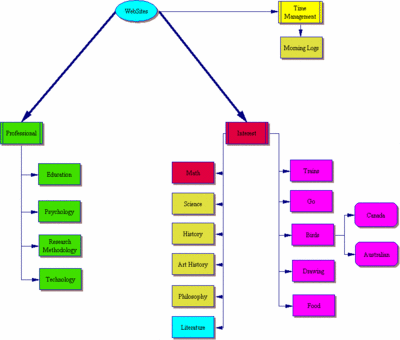
The first category shows four sub-categories under the umbrella term of "professional" topics. The next major category is "personal interest" which I have sub-divided into "academic" and "life". The academic group includes 6 topics and the life group has 5. There is one other meta-topic, which I call "time-management" as I spend explicit time on this as well as on the actual Learning activities.
In addition to identifying the main topics and sub-topics, I also use color to help highlight the identity of each group while also adding a special level of detail to some items. For example, I use red to emphasize that "math" is my top priority in the "personal interest" group, and turquoise to identify "literature", which usually means reading a novel, short story or poem, as a different kind of activity from the other items which have more of a knowledge dimension.
In addition to Inspiration, which I have been using for over a decade, I also use two other software packages for drawing such concept maps: MindGenius and cmap. The latter is a free open source product. More information on any software that I happen to mention can easily be found by googling the name.
I then use this map to remind me of possible entries when I build my table of Learning activities. This table is divided into a top and bottom half, the top containing activities for the current day and the bottom containing activities that I should consider moving up to the top half when I think I can realistically fit them in. It is also possible to move an item down to the bottom half if my priorities alter due to changing circumstances.
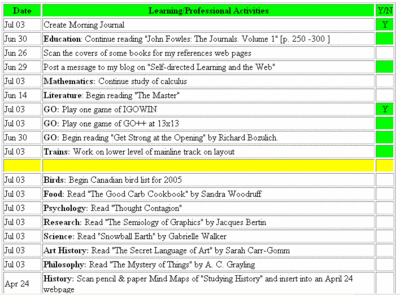
As you may notice, I have just used the Learning Activities map to identify a number of potential future activities which I have added to the bottom half of the daily table which I update each morning (or at least on most mornings).
I make use of color with this table as well. I make a green square to indicate that I definitely plan to complete that item today. I add a "Y" (short for Yes) to indicate that I have completed the item. For today by 9 am I have completed 2 items and still have 5 more items that I hope to complete, one of which is making a post to this blog. I will be adding a "Y" to that row in a moment.
Creating a daily table first thing each day only takes a few minutes since I simply copy the previous day's table and then make a few modifications. One could use Word or Excel to make these tables although I prefer using the web authoring package Dreamweaver. One may also save each day's table as a file and then refer to them for some form of review when the mood arises.
Although this may appear to be a laborious activity it is actually very efficient once one creates the initial chart and daily table. The main challenge is that of establishing the discipline to maintain the process (almost) each day.
posted by Dale @ 9:07 AM
Sunday, July 03, 2005
John Fowles and the OED
As indicated earlier, I am reading "John Fowles: The Journals. Volume 1" (2004) edited by Charles Drazin. Here is a quote from page 372:"I get pleasure too from reading the OED - the pure charm of words. I read slowly through the whole dictionary, missing nothing. Only halfway through C. But life is long."
posted by Dale @ 2:10 PM
Monday, July 04, 2005
Self-Directed Learning of Calculus - Part 1
One of my current interests is to relearn calculus. One approach would be to take a first year university course on the topic, either as an audit or as a registered student. But my preference is to direct my own Learning. The road less travelled ...My first step was to review a number of potential resources (both books and online). In the case of books I spent quite a few hours using both Google and amazon.com to locate information and reviews of calculus textbooks and resources. I also visited the local bookstores and university library to examine the books on their shelves.
Once again, I was at a decision point. I could have opted for one good book and worked my way through it. This would have been very close to a course approach with one textbook. But I realized almost immediately that I wanted to use more than one book. They all have different approaches and emphasises. The real goal is not to Learn a book, but to Learn the topic (i.e. calculus) in a deep and substantive manner. Thus I wanted to see how the topic was presented by a number of different authorities.
I have ended up with 5 books. Two of the books are introductory books for the general public and are an excellent introduction to the topic.
- Calculus Made Easy (1998) by Silvanus P. Thompson & Martin Gardner. This is a modern revision of a 1910 classic.

- The Complete Idiot's Guide to Calculus (2002) by W. Michael Kelley. This is considered to be a useful supplement to a more rigorous textbook.
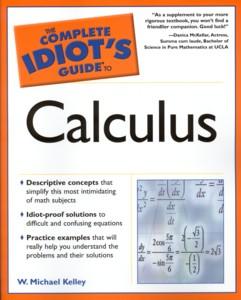
One of the advantages of the above two books is that they are relatively small and thus tend to focus on the important concepts and leave the details to other sources. They also have a friendly informal style.
The remaining three books are university level textbooks.
- Calculus: An Intuitive and Physical Approach (Second Edition)(1977) by Morris Kline. This is an oft-quoted classic that is still in print, an excellent indicator of its value.
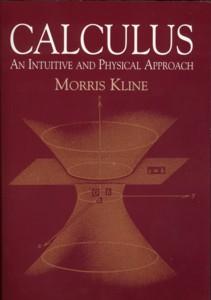
- Calculus With Analytic Geometry. 6th ed. (1998) by Larson, R. E, Hostetler, R. P. & Edwards, B. H.. I bought this textbook in a used bookstore for a small fraction of the cost of a new edition. I had noticed many references to it on the Web and recognized the title when I was browsing the bookshelves. It is a thick and very heavy book. I feel confident that if I can handle this book I will be on top of the topic.
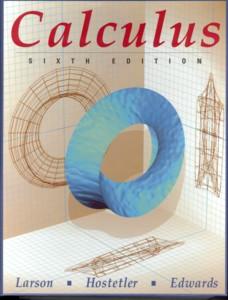
- Calculus. 3rd ed. (1994) by Michael Spivak. This received the highest comments on my Web searches, but the comments indicated that it was not for everyone. I located a copy of the original first edition (1967) in the university library and loved it. The emphasis is much more on the concepts and proofs than on applying algorithms to solve problems. Using the Web I was able to purchase a copy of the latest (1998) edition from the publisher.

I think that the combination of these 5 books should give me a good set of resources for my Learning activities.
Summarizing, I used the Web as well as bookstores and libraries to review a number of books on calculus, finally selecting 5 books for purchase. A promising start.
posted by Dale @ 10:35 AM
Wednesday, July 13, 2005
Self-Directed Learning of Calculus - Part 2
There are many ways and styles for creating notes while Learning a topic.I would like to share some approaches that I use while using technology to support my Learning of calculus. Many of these approaches use a table structure, but it is primarily because the tables are created using computer software that they achieve their value. It is the flexibility that arises because the table may be edited (i.e. updated)that gives it the power to be useful over that of a paper-based table.
The first table that I create maps out the overall set of chapters in the five books that I am using to study calculus. In this particular situation I have created a table specifically for the "prerequisites" to the actual topic of calculus.
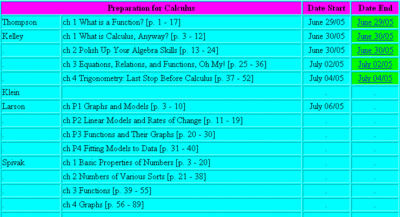
The table has a few notable features.
1)It is another aid to time management, which takes on more importance when one is engaged in Self-Directed Learning.
2) It provides an overview of what is planned for the coming open-ended time period. In this case it identifies all of the chapters in the five books I am using that describe the pre-cursors to the actual studying of calculus. Since I have been away from any formal use or study of mathematics for about 40 years, this seems like a useful way to start. One concern with this approach is that I may bog down in minutia and never get to the primary goal of learning calculus. One should try to establish a balance between meaningful learning and efficient learning. The goal is not to document how faithful I have been to a strategy, but to keep the strategy itself flexible to modification as one proceeds.
3)I do not make definitive Learning plans for more than a week in advance. That is, my plans are not rigid and are open to the numerous other events that make my life worthwhile.
4)More playfully, I insert color into the table to help highlight the successful completion of an activity.
5) In my opinion most importantly, the actual construction of the table forces me to think and to identify the main topics for study in the near future. Often this is done for one when one is taking a course, but when one is planning their own Learning it helps to draw a roadmap. This might be viewed as a form of "advance organizer" for what is to come.
6) The actual time taken to create such a table is relatively short, less than an hour.
7) Once one has created one such table this may be used as a form of template to create other tables. One need only copy the table, clear out most of the rows and type in the new content.
8) The table can also be viewed as a window into progress, or lack of progress. In my case it is more of the latter at the moment. It has been exactly a week since I last looked at a calculus book. No problem - it is summer after all, but still, it is a jog to not let this slip too far.
9) And given that I should get back on task, it helps bring me back to where I last was and what should be done next.
All in all, that is pretty good service for one small table.
posted by Dale @ 6:48 AM
Thursday, July 14, 2005
Constructivism
The theme underlying this blog is that of Self-Directed Learning. The specific example is that of my efforts to Learn calculus (again). But the psychological theory that provides me with my direction is constructivism, an increasingly popular perspective within the cognitive (a word worth looking up in the OED)tradition.I have always had a cognitive orientation, which was reinforced when I was a graduate student in the late 1960's. I remain deeply indebted to three professors at the University of Alberta at the time: Steve Hunka, Don Fitzgerald & Tom Maguire, who provided the support and encouragement to swim against the current and who exemplified the notion of Self-Directed Learning 40 years before the term became common. The constructivist philosophy became the heart of my approach when I became heavily involved with children and Logo in the early 1980's. I continue to believe that Logo was a superb idea and am still saddened when I realize how badly Education dropped the ball by failing to realize that it was an approach to mathematical thinking and not just another computer language.
The above reflections were precipitated by the second edition of "Constructivism: Theory, Perspectives, and Practice" (2005) edited by Catherine Twomey Fosnot. I ordered this book a couple of weeks ago and had my first look at it yesterday while sipping a coffee, alone, in a local cafe. The short opening chapter by one of the leading proponents of constructivism, Ernst von Glasersfeld, is stunningly simple. Drawing on Piaget's epistemology (another word worth looking up in the OED), Glasersfeld says, "... what we see, hear, and feel - that is, our sensory world, is the result of our perceptual activities and therefore specific to our ways of perceiving and conceiving. Knowledge ... arises from actions and the agent's reflection on them" (p. 4).
Glasersfeld continues, "... the way we segment the flow of our experience, and the way we relate the pieces we have isolated, is and necessarily remains an essentially subjective matter. ... The conceptual structures that constitute meanings or knowledge are not entities that could be used alternatively by different individuals. They are constructs that each user has to build up for him- or herself. And because they are individual constructs, one can never say whether or not two people have produced the same construct." (p. 5)
The above quotes have been yellow-highlighted in my copy of the book.
All of the above applies seamlessly to my efforts to Learn calculus. And it is worth noting that fundamentally ALL such efforts must be Self-Directed. The term Self-Directed Learning is redundant, but the emphasis is worth repeating.
I am also reading a novel, "The Master" by Colm Toibin, which is a fictionalized biography of the writer Henry James. Here is a quote from that book that I noticed yesterday which reinforces the above comments by Glasersfeld: "The gap between these two desires filled him with sadness and awe at the mystery of the self, the mystery of having a single consciousness, knowing merely its own bare feelings and experiencing singly and alone its own pain or fear or pleasure or complacency" (p. 167).
I have an appointment in a coffee shop within the hour with a colleague who has also purchased the book on constructivism and we will attempt to communicate with our individual minds. Such social events are another way to engage in Learning.
posted by Dale @ 7:00 AM
Friday, July 15, 2005
Stubborness or Perseverence?
This morning I had a good session for Learning calculus. I failed to make any progress on calculus but I would still rate it as a good session.One of the tangential pre-calculus tasks for the Larson text require that one use a computer or calculator to perform a regression analysis for various data sets. I have three software packages that are candidates for doing this: SPSS, Mathematica and Scientific Notebook.
I am quite familiar with the topic of regression analysis and know how to use SPSS to conduct such an analysis. However I have no idea of how to use either Mathematica or Scientific Notebook to do such an analysis. The goal for today was to see if I could figure out how to use Mathematica for this task. In addition to the Help menu for the software, I have one book on the general use of Mathematica: "Mathematica Navigator. Second edition" (2004) by Heikki Ruskeepaa.
After a short time I realized that this was going to be more difficult than I first thought. One of the pre-requisites is a familiarity with Lists and Tables and how they are handled by Mathematica. Although I could follow some of the examples in the Ruskeepaa book, I could not see how to transfer this knowledge to the situation of inputting my own data.
I decided to see if I could find additional information on the Web using Google. Although I found a number of web sites, none of them proved useful. I did find information of a couple of online courses offered by Mathematica that specifically dealt with statistics and linear regression. It was very tempting to opt for this and have someone explain everything to me but that would mean waiting a month or so until the course was next offered. I decided to see if I couldn't figure it out on my own.
With numerous attempts, numerous error messages, and the occasional inappropriate display, I finally figured it out. The overall time from start to finish was 3 hours. However the feeling of satisfaction when I finally had it under control made the time spent feel worthwhile.
The judgement calls of when to try what are a critical feature of all Learning, particularly when the activity is Self-Directed. There is no guarantee that a specific approach or strategy will actually work, and trying hard does not always lead to success. In the words of Kenny Rogers, "you have to know when to hold them and you have to know when to fold". Such knowledge is not algorithmic, but highly intuitive, based on one's entire life history.
It would be easy to be discouraged about an effort that took 3 hours and which would have only taken about 15 minutes if I had known the actual steps to be followed. Some tools are more complex and more difficult to master than others, and what is difficult for one person may be either easier or impossible for another.
Tomorrow I plan to carry out a number of analyses and expect that my attention will be able to focus on the mathematics of the situation rather than on Learning to use the tool. But the important accomplishment today was to Learn to use the tool, in this case, Mathematica, to perform a regression analysis. And I feel good about this.
posted by Dale @ 2:52 PM
Monday, July 18, 2005
Knowledge Structures and Constructivism
Yesterday I "read" a psychology book about memes (Thought Contagion by Aaron Lynch, 1996). Total number of pages 192. Time spent: about an hour.I did not read every word. First, I had a look at the table of contents. The book contained 7 chapters plus a short epilogue chapter at the end. Each chapter had a number of phrases corresponding to a series of sub-headings (between 10 and 20).
I began reading the first chapter and part of the second when I first sensed the actual structure of the book. I then opened a software package called MindGenius that I use for creating mind maps of content that I am playing with. I quickly had a series of branches for the first chapter and part of the second. At that point I realized that for my purposes, I did not need to read all of the book. Chapters 2 through 6 each consisted of a specific example within different disciplines. The general ideas were encapsulated within the first chapter, chapter 7, and the eplogue. I quickly completed a chart for the entire book that reflected this structure.
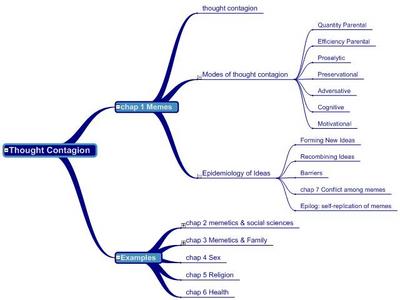
Thus the chart that I created is different than the one implicit in the book. Fair enough. A book is not something to be memorized but a resource for the reader to think about. We each have our own personal knowledge structures (this is the core tenant of constuctivism), which are also usually implicit. We rarely try to explicitly construct a map of a topic that reflects our personal understanding of the topic. Yet by constructing such a map one can often be much more efficient in Learning the material. In this case I was able to skim read most of the chapters, focusing on the first and last chapters.
Reading is not "barking at print". Rather it is interpreting print based on one's current knowledge and understanding. By creating explicit diagrams that identify the main ideas and concepts one can continually reflect on the structure and modify it to accommodate new ideas. This is where software packages can make a real difference. It is relatively easy to modify the diagram: adding, deleting, and moving items around until one is satisfied with the result. This process of continually creating and modifying a knowledge structure requires that the reader be an active agent. One must genuinely engage with the material.
I have provided a number of examples of using a structure (e.g. a table) to monitor my Learning of calculus and to facilitate time management. Such tables become a part of my Learning framework and permit me to continually reflect on how well I am doing. Sometimes this acts as a goad to focus on certain activities, and sometimes the table needs modification to reflect changing circumstances.
Thus I use two different types of structural diagrams (tables and node-maps) to guide my Learning and understanding of topics that are of interest to me. By using software packages to create such structures I have an environment that is both easy to use and m perhaps more importantly, easy to modify. Such diagrams are also an excellent way to communicate one's understanding.
posted by Dale @ 7:50 AM
Wednesday, July 20, 2005
Self-Directed Learning of Calculus - Part 3
Tables are ubiquitous to Learning. I have previously indicated how I use tables to assist me in time management. This post will display four types of table that I use to make my notes about the content that I am Learning.
I have created the following table to guide me as I read and work my way through a chapter in a book.
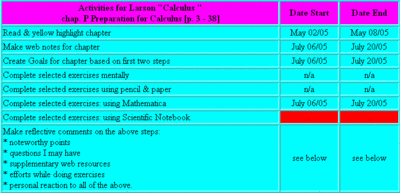
The table was created using Dreamweaver for use on a web page, however any software program that creates tables (e.g. Word, Excel) could also be used.
This table acts like a template. Each time I begin a new chapter in a calculus book, I simply copy this table and modify the dates in the right-most two columns. Each row consists of one of the steps that I have identified as being important for developing a deep understanding of the content. The overall table acts like a checklist to ensure that I have not inadvertently missed a step. On the other hand I may place a n/a for "not applicable" in a cell to indicate that the step does not appear to be important for this particular chapter. I have used the idea of color (red) to indicate a step that I have not yet attended to, but plan to, in the near future.
The next table that I create is for actually making notes of the content. Here is a sample from one such table:
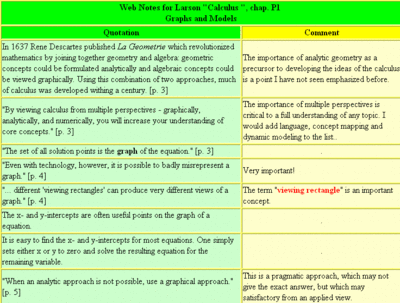
The first column contains either a direct quote or a summarizing statement in my own words of an important idea or point. The second column indicates the page number in the book in case I wish to refer back to this information at a later time. The third column contains my personal comments or reaction to the content. Once again, explicit reflection is an important component of my Learning strategy.
Here is a second example where I have embedded a table within a cell in order to make the steps in a mathematical proof as clear as possible.
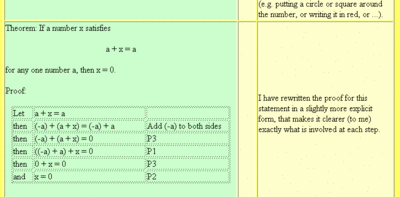
One more table! The premise of this blog is that one is interested in Learning that is Self-Directed. In such cases one usually does not have an instructor who can state at the outset the goals for the lesson or unit. Thus the formation of a table that identifies the goals is the last step, rather than the first, that I engage in while Learning the material in a chapter. Here is an example:
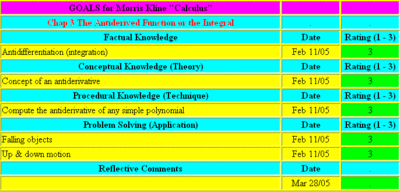
This particular table utilizes 5 different types of knowledge outcome. Depending on the chapter there may be only a few, or very many, different entries for each category. When Learning other topics, one may want to create a different system. Reflecting on the type of knowledge that is important is itself an important aspect of Learning.
I also utilize color in the third column to emphasize the degree to which I believe that that understand the topic (green for "3" which symbolizes confidence, yellow for "2" which indicates partial understanding, and red for "1" which means substantial effort is still required. Reviewing this table at any time can be a guide as to where I should devote my energy. It may also be appropriate to change the rating and color to reflect a change in my understanding (i.e. forgetting!). Here is a table with such colors:
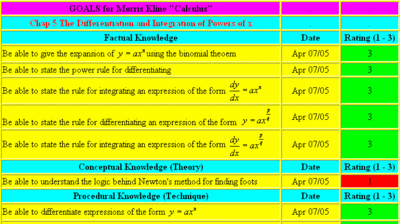
Clearly, I find tables to be useful for organizing my Learning in at least four distinct ways:
1) as a checklist for following the identified steps in my Learning,
2) as a way of structuring my notes to incorporate reflective comments,
3) as a way of structuring the format of mathematical proofs,
4) as a way of identifying and organizing the important ideas of the material.
Comments and suggestions are welcome!
posted by Dale @ 11:00 AM
Friday, July 22, 2005
Constructivism
The above paragraph is my personal road map to the future. It is also a map of the present and without much additional thought, a map of the past. The map is created by myself and is self-referential in that it is continually being referred to and modified as time progresses.
While I have stated my preference for a constructivist approach to Learning, and have used that as a guidebook for the last 30 years, I continue to enjoy reading, studying, and thinking about the topic. My three favorite authors are Jean Piaget, Lev Vygotsky and Jerome Bruner. My favorite sources for information specifically on constructivism are Ernst Glasersfeld, Paul Cobb and Seymour Papert. Cobb has written extensively on constructivism and mathematics learning whereas Papert has emphasized the role that technology can play in learning to think mathematically.
I recently purchased the book "Constructivism: Theory, Perspectives, and Practice. Second edition" (2005) edited by Catherine Twomey Fosnot. The second chapter provides an introduction and overview of constructivism. I began reading this chapter about an hour ago and quickly realized that I needed a map to envisage the overall structure of the chapter. I immediately quit reading and opened up my MindGenius software.
It only took about 15 minutes to create a chart based on the headings and subheadings of the chapter.
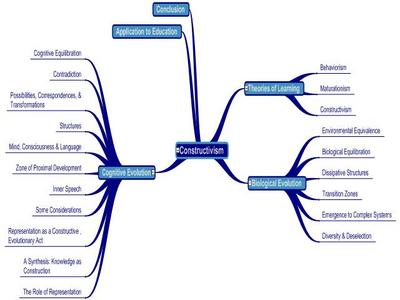
As a result of creating the image, I was aware that the chapter contained a fairly traditional and reasonable structure consisting of a brief review of theories of learning, and of biological approaches to learning, followed by a major section on constructivism and then a very brief section on education and a concluding paragraph.
The short concluding paragraph contains only 4 sentences, the third one being "It is a theory based on complexity models of evolution and development." For me, this is an important sentence. I am familiar with complexity models and the important idea of emergence but this is the first time that I have seen these models explicitly utilized as the framework for understanding constructivism. I suspect that I have been falling behind the current literature on constructivism - this is a bit of a wake-up call. I have yet to read the chapter, but I now have a good sense of what to expect. Reading for me is an example of a constructivist activity where I first try to imagine/create a structure that captures the overall framework and then I begin to actually "read" the words and yellow-highlight important passages. Yes, I mark up my books. The action of highlighting forces me to slow down and reread a section while also allowing me to review the book later more efficiently. If I decide it is appropriate I can also use this highlighting to efficiently extend my cognitive map that I have created with the MindGenius software. Then I can refer to this map at a later time when for some reason I wish to review this material.
My next step was to read the short section on education. Once again, a sentence jumped off the page at me: "Constructivism is a theory about learning, not a description of teaching." That is my interest and the central theme of this blog. I am interested in how I, the learner, can learn. And in my case this learning is totally self-directed. I am learning about learning and about calculus simply because I find it enjoyable. It engages my mind.
Now to sit back with a fresh cup of coffee, my mental map of the chapter, a yellow highlighter and the book and see what flesh I can attach to the bones.
Tuesday, July 26, 2005
Mathematical Notation
However with the advent of typewriters and computers the conventions previously arrived at have turned out to be very difficult to transcribe onto paper or the screen.
I am making (almost) all of my notes as web pages. In order to capture the notational complexities I use a combination of two different software packages. I begin by using Dreamweaver to create my basic web page. However when I encounter a mathematical expression that is difficult to express in Dreamweaver I switch to Microsoft Word which has been extended with the software package MathType 5. It is relatively easy to compose the mathematical expression using MathType, then save the result as an image (i.e. a gif file) and then paste this image into the Dreamweaver file. This actually sounds more complicated that it is in practice. Creating the expression is straightforward (once one becomes familiar with MathType - which is easy) and the saving and retrieving of the image is just a few mouse clicks).
Here is an example:
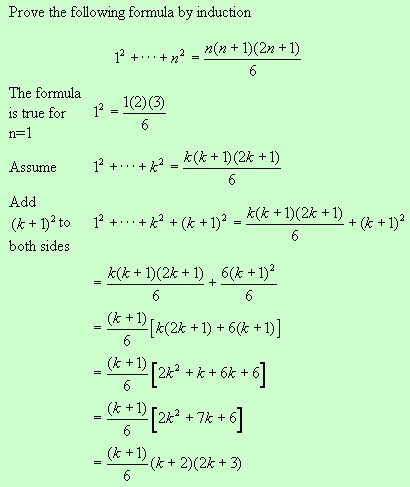
posted by Dale @ 9:35 AM 0 comments
Thursday, July 28, 2005
Number Theory
I began reading a new novel last evening, "the curious incident of the dog in the night-time" by Mark Haddon. I love it!On page 12 I encountered the following: "Prime numbers are what is left when you have taken all the patterns away."
I bought two books last year that I have glanced at, but have yet to read slowly. The first is called "Prime Obsession: Bernhard Riemann and the Greatest Unsolved Problem in Mathematics" by John Derbyshire. The second is "Stalking the Riemann Hypothesis: The Quest to Find the Hidden Law of Prime Numbers" by Dan Rockmore.
If one needs extrinsic motivation, there is a prize of one million dollars for the individual who is able to prove that the Riemann Hypothesis is true (or false).
Number theory and the subset that deals with prime numbers (i.e. numbers that have no divisors other than 1 and the number itself) is a branch of mathematics that is fascinating in its own right. Surprisingly it is also relevant to the idea of developing codes that are unbreakable, a topic of current interest with the surge of interest in the Internet and the World Wide Web.
In addition to my interest in calculus, I am interested in learning more about number theory. However these topics all have a way of interlocking. The two fundamental ideas of calculus are those of function and limit. The same two ideas are at the heart of the Riemann Hypothesis.
The Mark Haddon novel continues, "I think prime numbers are like life. They are very logical but you could never work out the rules, even if you spent all your time thinking about them."
posted by Dale @ 5:45 AM 0 comments
Wednesday, August 10, 2005
Websites as Notebooks
The following comments apply to both my Learning of calculus as well as to other areas of Learning that I am interested in.I have just finished reading and making a mindmap for the book "Tomorrow's People" (2003) by the neuroscientist Susan Greenfield. In my first read through I made a small ink mark in the margin when I noticed a point that I found particularly striking or important.
On the second reading, I created a mindmap using the software MindGenius. This really helped me identify the important points and see where they fitted in the overall description of her views about the future.
As I have indicated on many posts to this blog, I am keeping my notes as a website (currently located on my hard drive) using the web authoring package Dreamweaver. As with any website, I have the capability to make links to other web pages (both my own as well as to external web resources) and perhaps more importantly, to files created by other software programs. Links to these files will work, and as long as the user has the same software that originally created the file, the file will open in that environment where one has dynamic control of the file.
In the case of this mindmap, this is preferable to seeing a static portion of the map on the screen. I can scroll through the complete map or collapse and expand nodes to suit my current area of interest. The difference is dramatic.
Similarly, when I am Learning calculus, I can use sophisticated software such as Mathematica to explore my ideas and these files can be saved and accessed from within the website that contains my narrative notes. Thus my electronic notes are much more than just a static textual presentation. They permit me to quickly move among various software packages with just a couple of mouse clicks and give me the added power that each package provides.
There is no doubt in my mind that these web-based notes are superior to anything I might try to create using more conventional materials. Each reread of the book, each paragraph that is created as part of note-making, each activity that uses a software package to play with the ideas provides numerous opportunities for review and enhancement. The cumulative effect of all these activities is to modify my neural patterns (a point made repeatedly by Greenfield) which is then manifested by my being able to engage in other activities such as a discussion (perhaps on a blog) that exhibits aspects of this new Learning experience.
posted by Dale @ 7:00 AM 0 comments
Thursday, August 25, 2005
Calculus and Number
Here are two quotes that I have noted in the last few weeks. The first was from the Michael Spivak book on calculus: "A great deal of this book is devoted to elucidating the concept of numbers, and by the end of the book we will have become quite well acquainted with them. ... It is therefore reasonable to admit frankly that we do not yet thoroughly understand numbers. ... we will have to consider a little more carefully what we mean by 'numbers'. " [p. 12 - 13]Then yesterday, while collecting my books, I came across a textbook from my last year of undergraduate study, "Principles of Mathematical Analysis" by Walter Rudin (1964). Here is the first sentence of the book: "A satisfactory discussion of the main concepts of analysis (e.g., convergence, continuity, differentiation, and integration) must be based on an accurately defined number concept." [p. 1]
Thus I now feel that I should embark on a two-prong approach to Learning calculus. In addition to focusing on calculus, I now want to spend a similar amount of time on studying numbers themselves. If nothing else my approach to Learning remains flexible. In passing I notice that the undergraduate curriculum where one takes a few courses at the same time, but where the courses have some overlap, is consistent with what I am now endeavoring to undertake. The real issues are time, and intellectual background. Since almost all of the actual mathematics that I once studied has not been used in over 40 years it seems fair to assume that the actual detail is forgotten. Fortunately the positive aura surrounding the detail is still intact, which should be a valuable support to my future Learning.
The blog I am currently using does not have the power to capture my notes so I will begin a new web site that chronicles my efforts. I will post the link on this blog when I have it ready.
I have accumulated a substantial number of books on number. It is time I spent some time with them. The first task is to collect them into one area on my book shelves.
There are moments when I feel that I am collecting butterflies. There are many kinds of numbers: the natural numbers, the integers, prime numbers, odd numbers, even numbers, rational numbers, irrational numbers, imaginary numbers, complex numbers, transcendental numbers, cardinal numbers, ordinal numbers, congruent numbers, ... I have also seen a quote ascribed to the German mathematician Kronecker in a number of my books, "God created the natural numbers, the rest is the work of man."
I find it fascinating to look at the books I have on number. There are a total of 25 that have a major emphasis on numbers. I have about a dozen on calculus. All of these books describe some aspect of the topic with some having a fairly well-defined sequaence and structure while others are more like a collection of interesting facts and problems.
However none of the books describe the actual process of Learning the material, not do any of them attempt to describe the actual mathematical knowledge that the author possesses about the topic. In fairness some of the books do attempt to convey a sense of the excitement of playing with the topic, but I have not seen a book that tries to set out how the author conceptualizes the topic and how she explores ideas within the topic. This blog has been a preliminary attempt to do this, and my future web site will be a more detailed description of my personal journey over the next few years.
However the real goal is not this blog, nor my web site. The real goal is the modification of my mind to better incorporate a number of mathematical ideas and to improve my understanding of mathematics and hence of science and philosophy. The blog and web site are only cloud chambers of an underlying mental transformation.
posted by Dale @ 5:31 AM 5 comments
Next Page |